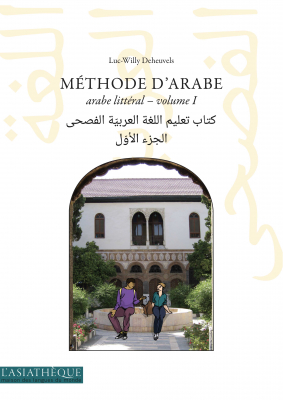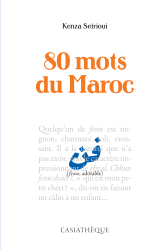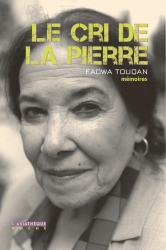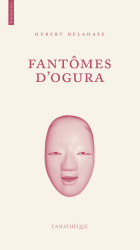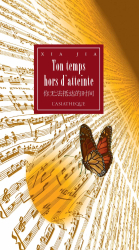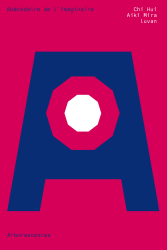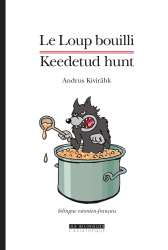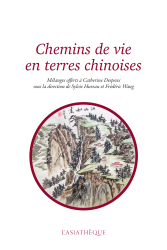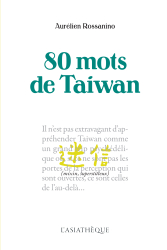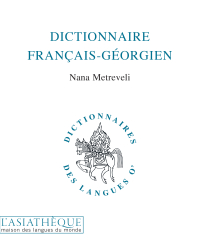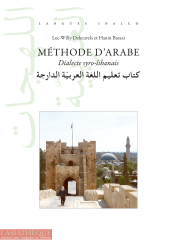Details
Format: Paperback
ISBN: 9782360573004
Collection: Langues INALCO
17 x 24 cm
Weight: 616 gr
Pages: 368
First publication: 09/02/2022
Last printing: 10-2024
CLIL: 3034
Méthode d’arabe 1 (Livre + audio)
(Arabic Language Method (Book + audio))
arabe littéral — volume 1
(literal Arabic - volume 1)
Un ouvrage de référence renouvelé pour l’apprentissage de l’arabe (A renewed reference book for learning Arabic)
New Méthode d'arabe - arabe littéral - volume 1 (published 2022 Feb 16).
This book offers a guide to modern Arabic, the national language of all member countries of the Arab League, very close to the classical registers of the Koran and medieval literature. This first volume is devoted to standard Arabic, used universally in writing (literature, press, correspondence, signs and panels, etc.) and in certain oral contexts (radio, television, speeches, conferences).
This method is designed to acquaint students with the Arabic language as quickly as possible within the framework of a university education. It is also intended for the self-taught learner and gives them all the elements they need to progress independently. Almost all written Arabic is produced without the short vowels written in.
This method is designed to allow the beginner to familiarise themselves with this reality as smoothly as possible. Learning to read without vowels is one of the essential goals of this method, which proposes the progressive acquisition of the different patterns of the language. The importance given to oral expression is illustrated by numerous dialogues designed to make learning more lively and spontaneous. This learning process is supplemented by audio material: recordings of all the texts, solutions to the reading and speaking exercises (to be listened to directly in the book with the QR codes and also available to download free of charge).
At the end of the book there are the vocalized texts, a French-Arabic lexicon and an Arabic-French lexicon.
Levels A1 and A2 of the Common European Framework of Reference for Languages (C.E.F.R.L.)
Volume 2 (levels B1 and B2) is being preparared as well as the following dialect handbooks: « Méthode d’arabe - arabe marocain » ("Arabic method - Moroccan Arabic"), « Méthode d’arabe - arabe syro-libanais » ("Arabic method - Syro-Lebanese Arabic"), Méthode d’arabe - arabe tunisien » ("Arabic method - Tunisian Arabic" ), « Méthode d’arabe - arabe koweïtien » ("Arabic method - Kuwaiti Arabic"). All these works are authored by Luc-Willy Deheuvels with the help of the various teachers concerned at INALCO (National Institute of Oriental Languages and Civilizations in Paris, France).
- A book resulting from a long experience of teaching, compellingly presented, richly illustrated, with numerous texts and exercises.
- Accompanying booklets in different dialects of Maghreb and Middle East are being prepared.
- Extreme attention to speaking: full recording of oral readings and exercises.
MEDIA LIBRARY
Audio recording
CONTRIBUTORS' BIOGRAPHIES
Luc-Willy Deheuvels

Luc-Willy Deheuvels has an agrégation in Arabic and is Professor Emeritus at the Institut national des langues et civilisations orientales (Inalco). He is the author of Méthode d'arabe - arabe littéral volume 1, published by L'Asiathèque. The two volumes of the new method will replace the Manuel d'arabe moderne volume 1 and the Manuel d'arabe moderne volume 2 by the same author, previously published by L'Asiathèque.e moderne volume 1 and the Manuel d'arabe moderne volume 2 by the same author, previously published by L'Asiathèque.
TABLE OF CONTENTS
Présentation (Introduction)
Orientations bibliographiques (Bibliographical guidance)
Principaux signes et abréviations (Principal signs and abbreviations)
Plage des enregistrements audio (Audio recording range)
(Leçon 1) Lesson 1
Se présenter - début de l’alphabet. (Introducing yourself - the beginning of the alphabet.)
- Texte I. 1 - Vocabulaire - Texte I.2 - Vocabulaire - Texte II - Vocabulaire - Grammaire - Traduction du texte - Exercices (- Text I.1 - Vocabulary - Text I.2 - Vocabulary - Text II - Vocabulary - Grammar - Translation of the texts - Exercises)
Leçon 2 (Lesson 2)
Saluer, parler de son travail, dire où on habite, téléphoner ; poursuite de l’alphabet. Jusqu’à la leçon 4, l’apprentissage des textes est avant tout oral avec l’écoute, la répétition des dialogues et la mémorisation du lexique. La transcription est une aide à la mémorisation utile dans les premières leçons. (Greetings, speaking about jobs, saying where you live, making phone calls; continuation of the alphabet. Until lesson 4, the learning of texts is primarily oral with listening, the repetition of dialogues and the memorization of the lexicon. The transcription is a useful aid to memorization in the first lessons.)
- Textes I.1. et I.2 - Vocabulaire - Textes II.1. et II.2 - Vocabulaire - Grammaire - Traduction des textes - Exercices (- Texts I.1. et I.2 - Vocabulary - Texts II.1. and II.2 - Vocabulary - Grammar - Translation of the texts -)Exercices (Exercises)
Leçon 3 (Lesson 3)
Se déplacer, compter de 0 à 5, apprendre à désigner quelque chose et à écrire les chiffres indiens, poursuivre l'étude de l'alphabet. (Moving around, counting from 0 to 5, learning to refer to something and to write Indian numbers, continuing study of the alphabet.)
- Texte I.1 - Texte I.2 - Vocabulaire - II. Compter de 0 à 5 - Vocabulaire - Grammaire - Traduction du texte - Exercices (- Text I.1 - Text I.2 - Vocabulary - II. Counting from 0 to 5 - Vocabulary - Grammar - Translation of the texts - Exercises)
Leçon 4 (Lesson 4)
Arriver à l’aéroport et prendre un moyen de transport. Exprimer la possession. Apprendre de nouvelles formules de politesse et de salutation. Poursuivre l'étude de l'alphabet. À partir de cette leçon, les textes sont repris en graphie arabe, en lecture et en écriture. La transcription reste une aide pour la mémorisation, mais elle diminue graduellement pour disparaître après la leçon 8. (Arriving at the airport and taking a means of transport. Expressing possession. Learning new forms of politeness and greeting. Continuing to learn the alphabet. From this lesson onwards, the texts also appear in the Arabic script, both for reading and writing. The transcription remains an aid to memorization, but it gradually diminishes and is no longer used after lesson 8.)
- Textes I.1. et I.2 - Vocabulaire - Texte II - Vocabulaire - Grammaire - Traduction des textes 0 - Exercices (- Texts I.1. et I.2 - Vocabulary - Text II - Vocabulary - Grammar - Translation of the texts - Exercises)
Leçon 5 (Lesson 5)
Voyager en avion entre Paris, Tunis et Riyad. Téléphoner, compter jusqu’à 10 et donner l’heure. Poursuivre l'étude de l'alphabet et se confronter à de plus en plus de textes en graphie arabe, en lecture et en écriture. (Travelling by plane between Paris, Tunis and Riyadh. Talking on the phone, counting to 10 and telling the time. Continue learning the alphabet and learn to read and write more and more texts in Arabic.
- Text I.2 - Vocabulary - II. Counting from 6 to 10 - Vocabulary - Grammar - Translation the text - Exercises.)
Leçon 6 (Lesson 6)
Aller à l’hôtel. Chercher sur internet un hôtel à Marrakech et réserver. Décrire. (Going to a hotel. Searching on the internet for a hotel in Marrakech and booking. Describing.)
- Texte I - Vocabulaire - Grammaire - Traduction du texte - Exercices (- Text I - Vocabulary - Grammar - Translation of the text - Exercises.)
Leçon 7 (Lesson 7)
Passer une commande au café, et demander à un interlocuteur comment il va. Fin de l’apprentissage de l’alphabet et des signes graphiques. (Ordering at a café, and asking someone how they are. Finish learning the alphabet and the writing.)
- Texte I - Vocabulaire - Texte II - Vocabulaire - Grammaire - Traduction des textes - Exercices (- Text I - Vocabulary - Text II - Vocabulary - Grammar - Translation of the texts - Exercises)
Leçon 8 (Lesson 8)
Commander le petit déjeuner à l’hôtel et aller au restaurant avec des amis. S’entraîner à lire en graphie arabe et à se passer de la transcription. Travail accru de l’écrit. (Ordering breakfast at a hotel and going to a restaurant with friends. Practising reading in Arabic script and doing without transcription. Increased emphasis on writing practice.)
- Texte I - Vocabulaire - Texte II - Vocabulaire - Grammaire - Traduction des textes - Exercices (- Text I - Vocabulary - Text II - Vocabulary - Grammar - Translation of the texts - Exercises)
Tier 1 to 8 (Palier 1 à 8)
Récapitulation des notions acquises précédemment. Palier pour passer définitivement des transcriptions à la graphie arabe. (Revision of previously taught concepts. A stepping stone to definitively switching from transcriptions to Arabic spelling.)
- Grammaire - Exercices (- Grammar - Exercises)
Leçon 9 (Lesson 9)
Suivre des cours de langue et de philosophie à l’université, découvrir la déclinaison et apprendre les différents niveaux de lecture et de réalisation des énoncés. Déchiffrer des panneaux, et s’entraîner à lire en graphie arabe. (Taking language and philosophy courses at university, discovering the declensions and learning the different levels of reading and making statements. Deciphering signs and practising reading in Arabic script.)
- Textes I et II - Vocabulaire - Grammaire - Traduction des textes - Exercices (- Texts I et II - Vocabulary - Grammar - Translation of the texts - Exercises)
Leçon 10 (Lesson 10)
Compter jusqu’à 100, consulter la carte du restaurant, avec les prix, demander et régler l’addition. Découvrir les villes syriennes. Travailler sur les pluriels des mots connus. (Counting up to 100, consulting a restaurant's menu with prices, asking for and paying the bill. Discovering Syrian cities. Working on the plurals of known words.)
- Texte I.1 - Vocabulaire - Texte I.2 - Vocabulaire - III. Compter de 11 à 19 - IV. Les dizaines - V. Compter de 21 à 99 - Grammaire - Traduction des textes - Exercices (- Text I.1 - Vocabulary - Text I.2 - Vocabulary - III. Counting from 11 to 19 - IV. The tens - V. Counting from 21 to 99 - Grammar - Translation of the texts - Exercises)
Leçon 11 (Lesson 11)
Découvrir les centaines, faire des achats, changer de l’argent, faire ses courses au marché et aller au restaurant avec des amis. Déchiffrer des panneaux, et s’entraîner à lire en graphie arabe. (Discovering the hundreds, buying things, changing money, shopping at the market and going to restaurants with friends. Deciphering signs, and practising reading in Arabic script.)
- Texte I - Texte II - Vocabulaire - I. Compter : les centaines - II. Compter jusqu'à mille - Grammaire - Traduction des textes - Exercices (- Text I - Text II - Vocabulary - I. Counting : the hundreds - II. Counting to 1000 - Grammar - Translation of the texts - Exercises)
Leçon 12 (Lesson 12)
Se détendre avec des amis après les cours avec la découverte de plusieurs formes verbales dérivées. Un grand pas est franchi dans l’apprentissage des automatismes permettant de lire sans voyelles. S’initier également à la calligraphie avec une première écriture. (Relaxing with friends after class with the discovery of several derived verb forms. A big step is taken in learning the automatisms to read without vowels. You can also learn calligraphy along with your first handwriting exercise.)
- Texte - Vocabulaire - Grammaire - Traduction du texte - Exercices (- Text - Vocabulary - Grammar - Translation of the text - Exercises)
Leçon 13 (Lesson 13)
Après cette leçon, la géographie des États arabes (pays et capitales) n’a plus de secret. Participer à une émission-jeu à la radio, et suivre la vie d’un policier tranquille. Développer la compétence sur les règles d’accord au pluriel et les formes dérivées. Lire des titres de presse, et aller sur internet à la découverte de sites d’informations en langue arabe. (After this lesson, the geography of the Arab states (countries and capitals) is revealed. Participate in a radio game show and follow the life of a quiet policeman. Developing competence in the rules of plural agreement and derived forms. Reading newspaper headlines, and going on the internet to discover news sites in Arabic.)
- Pays arabes - Carte du monde arabe - Texte I - Vocabulaire - Texte II - Vocabulaire - Grammaire - Traduction des textes - Exercices (- Arab countries - Map of the Arab world - Text I - Vocabulary - Text II - Vocabulary - Grammar - Translation of the texts - Exercises)
Leçon 14 (Lesson 14)
Aller au cinéma, apprendre à donner son avis, à afficher ses préférences et à dire ce que l’on aime ou n’aime pas. Pouvoir raconter ce qui s’est passé après avoir vu la deuxième grande conjugaison de la langue arabe, l’accompli. Et puis poursuivre l’apprentissage de la calligraphie avec la découverte du dīwānī, du grand art ! (Going to the cinema, learning to give one's opinion, to show one's preferences and to say what one likes or dislikes. Being able to narrate what happened after learning the second major conjugation of the Arabic language, the past tense. And then continuing to learn calligraphy with the discovery of dīwānī, great art!)
- Texte - Vocabulaire - Grammaire - Traduction du texte - Exercices - Vocabulaire (- Text - Vocabulary - Grammar - Translation of the text - Exercises- Vocabulary)
Leçon 15 (Lesson 15)
Cette leçon montre que les compétences acquises permettent d’aborder près d’un millénaire et demi d’écrits en langue arabe. La langue arabe est d’une remarquable permanence dans sa syntaxe comme dans son lexique. Ainsi, une culture bien plus que millénaire s’ouvre à l’apprenant, préservée dans l’écrin de sa langue. (This lesson shows that the skills you have acquired are sufficient to understand almost one and a half millennia of writing in Arabic. The Arabic language is remarkably constant in its syntax and lexicon. Thus, a culture that is well over a thousand years old is unfolded for the learner, preserved in the setting of its language.)
- Texte - Vocabulaire - Grammaire - Traduction du texte - Exercices (- Text - Vocabulary - Grammar - Translation of the text - Exercises)
Leçon 16 (Lesson 16)
Consulter les horaires de bus sur internet pour aller de Tunis à Sousse, et réserver un billet pour voyager du Caire à Alexandrie. Mettre à l’épreuve ses connaissances en dīwānī pour déchiffrer une calligraphie ornementale. Élaborer des phrases de plus en plus complexes, et saisir, dans la logique interne de la langue arabe, la syntaxe de la phrase nominale. (Checking bus schedules on the internet to get from Tunis to Sousse, and booking a ticket to travel from Cairo to Alexandria. Test your knowledge of dīwānī to decipher ornamental calligraphy. Developing increasingly complex sentences, and grasping, within the internal logic of the Arabic language, the syntax of the nominal sentence.)
- Texte - Vocabulaire - Grammaire - Traduction du texte - Exercices - Vocabulaire (- Text - Vocabulary - Grammar - Translation of the text - Exercises - Vocabulary)
Leçon 17 (Lesson 17)
L’arabe de presse, avec l’écoute d’un programme de radio-Liberté, une interview d’une avocate de la cause féminine dans la Tunisie d’après la révolution, et une ouverture sur les journaux arabes d’aujourd’hui. Le verbe « être » est vu complètement et permet facilement de jongler avec les temps à partir de l’accompli et de l’inaccompli. (Understanding Arabic media, through listening to a radio programme, an interview with a women's advocate in post-revolution Tunisia, and an opening on today's Arab newspapers. The verb "to be" is seen completely and allows for easy juggling of tenses from the perfect to the imperfect.)
- Texte - Vocabulaire - Grammaire - Traduction du texte - Exercices - Vocabulaire (- Text - Vocabulary - Grammar - Translation of the text - Exercises - Vocabulary)
Leçon 18 (Lesson 18)
La littérature contemporaine, avec un univers proche des Mille et Une Nuits revisité par un grand auteur palestinien. Exprimer une pensée élaborée avec des phrases de plus en plus complexes intégrant relatives et complétives. Les compétences en graphie ruq ͑a deviennent utiles pour déchiffrer une lettre manuscrite écrite au Moyen-Orient. (Contemporary literature, with a world close to the Arabian Nights revisited by a great Palestinian author. Expressing an elaborate thought process with increasingly complex sentences integrating relatives and complements. The skills in ruq ͑a writing come in handy to decipher a handwritten letter written in the Middle East.)
- Texte - Vocabulaire - Grammaire - Traduction du texte - Exercices - Vocabulaire - Vocabulaire (- Text - Vocabulary - Grammar - Translation of the text - Exercises - Vocabulary - Vocabulary)
Leçon 19 (Lesson 19)
Un très grand auteur de la littérature arabe, Naguib Mahfouz, prix Nobel en 1988, accompagne cette leçon qui fait faire un saut important dans la lecture sans voyelles avec la fin de l’apprentissage de tous les schèmes de formes dérivées. On peut maintenant aborder des textes ardus sur des questions politiques d’actualité. L’expertise dans les calligraphies orientales permet d’établir le texte d’un diplôme. (A very important author of Arabic literature, Naguib Mahfouz, Nobel Prize winner in 1988, accompanies this lesson, which makes an important leap in reading without vowels, with the end of the learning of all the patterns of derived forms. Tough texts on current political issues can now be addressed. Expertise in oriental calligraphy enables the establishment of the text of a diploma.)
- Text - Vocabulary - Grammar - Translation of the text - Exercises - Vocabulary
Leçon 20 (Lesson 20)
Au terme de cette première découverte de l’arabe littéral, cette dernière leçon récapitule ce qui a été appris et apporte des compléments à ce qui a d'ores et déjà été acquis en matière d’autonomie en expression orale et écrite, comme en compréhension et en lecture ; on a désormais visité les principaux schèmes. Cette leçon met en situation sur un site archéologique, et fait également répertorier des pièces de musée. (At the end of this first dive into modern standard Arabic, this last lesson recapitulates what has been learnt and adds to the skills you have already acquired with respect to autonomy in oral and written expression, as well as in comprehension and reading; all the basics and patterns of speech have now been covered. This lesson involves a situation on an archaeological site, and also lists pieces in a museum.)
- Texte - Vocabulaire - Grammaire - Traduction du texte - Exercices - Vocabulaire (- Text - Vocabulary - Grammar - Translation of the text - Exercises - Vocabulary)
Lexique arabe-français (Arabic-French lexicon)
Lexique français-arabe (French-Arabic lexicon)
Textes vocalisés (Vocalised texts)
Corrigé des exercices (Solutions to the exercises)
